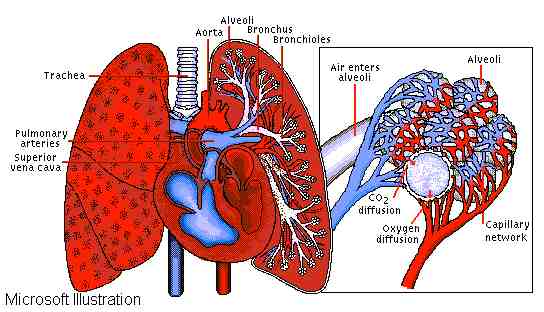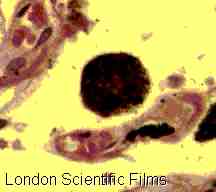
Lungs, paired
organs in the chest that carry on respiration. In the adult human, each
lung is 25 to 30 cm (10 to 12 in) long and roughly conical. The two lungs
are separated by a structure called the mediastinum, which contains the
heart, trachea, esophagus, and blood vessels. They are covered by a protective
membrane called the pulmonary pleura, which is separated from the parietal
pleura-a similar membrane on the chest wall-by a lubricating fluid. Inhaled
air passes through the trachea, which divides into two tubes called bronchi;
each bronchus leads to one lung. Within the lungs the bronchi subdivide
into bronchioles, which give rise to alveolar ducts; these end in sacs
called alveoli.
Respiration
In this life-supporting
process, oxygen from incoming air enters the blood; and carbon dioxide,
a waste gas from the metabolism of food, is exhaled into the atmosphere.
The exchange of gases takes place when air reaches the alveoli. These small
sacs are only one cell thick, and they are surrounded by blood capillaries
that are also only one cell thick. Air diffuses through these cells into
the capillary blood, which carries the oxygen-rich air to the heart to
be distributed throughout the body. In the alveoli, at the same time, gaseous
carbon dioxide diffuses from the blood into the lung and is expired.
Air enters
the lungs when the diaphragm, a strong muscle under the lungs, forcibly
lowers and enlarges the chest cavity in which the lungs are suspended.
This causes the lungs to expand, and the air to fill the enlarged lungs.
When the diaphragm relaxes, the lungs contract and the air is forced out.
In times of greater oxygen need, the rib cage can also expand, further
enlarging the chest cavity for greater air intake. A healthy adult can
draw in about 3.3 to 4.9 liters (about 200 to 300 cu in) of air at a single
breath, but at rest only about 5 percent of this volume is used. Lungs
also excrete water as gas; store glycogen, a complex carbohydrate; and filter out incoming organisms and dangerous particles via
hairs called cilia.
Diseases
Common infectious
lung diseases include pneumonia, which can be caused by bacteria or viruses;
and tuberculosis. Much more common now is cancer of the lung, which-with
the rise of cigarette smoking-has become the leading killer among cancers
in the U.S. Smoking also contributes substantially to the rise of chronic
bronchitis and emphysema. In the latter condition the alveoli are gradually
destroyed. Asthma, a severe constriction of the
bronchi, can be caused by sensitization to such natural materials as pollen
or to industrial chemicals. Fibrosis, or scarring, of the lungs is caused
by exposure to materials such as cotton dust (brown lung), coal dust (black
lung), and asbestos (asbestosis).


